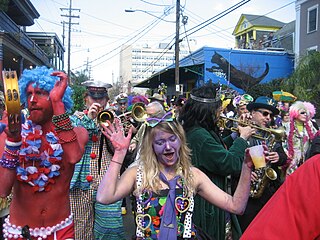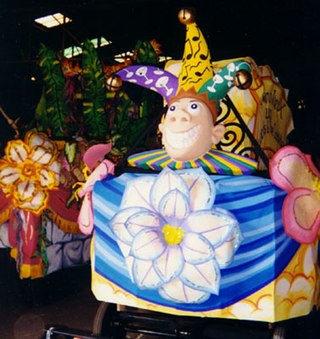
Mardi Gras is the final day of Carnival or Shrovetide before Ash Wednesday. Mardi Gras is French for "Fat Tuesday", reflecting the practice of the last night of consuming rich, fatty foods in preparation for the fasting season of Lent.

Carnival or Shrovetide is a Christian festive season that occurs before Lent, consisting of Quinquagesima or Shrove Sunday, Shrove Monday, and Shrove Tuesday or Mardi Gras.

A krewe is a social organization that stages parades and/or balls for the Carnival season. The term is best known for its association with Mardi Gras celebrations in New Orleans, but is also used in other Carnival celebrations throughout Louisiana and along the Gulf of Mexico, such as the Gasparilla Pirate Festival in Tampa, Florida, Springtime Tallahassee, and Krewe of Amalee in DeLand, Florida with the Mardi Gras on Mainstreet Parade as well as in La Crosse, Wisconsin and at the Saint Paul Winter Carnival.

The Sydney Gay and Lesbian Mardi Gras or Sydney Mardi Gras is an event in Sydney, New South Wales attended by hundreds of thousands of people from around Australia and overseas. One of the largest such festivals in the world, Mardi Gras is the largest Pride event in Oceania. It includes a variety of events such as the Sydney Mardi Gras Parade and Party, Bondi Beach Drag Races, Harbour Party, the academic discussion panel Queer Thinking, Mardi Gras Film Festival, as well as Fair Day, which attracts 70,000 people to Victoria Park, Sydney.

The Mistick Krewe of Comus (MKC), founded in 1856, is the oldest extant New Orleans, Louisiana Carnival Krewe, the longest to continually parade with few interruptions from 1856 to 1991, and continues to hold a tableau ball for its members and guests, to date. Initially its public facade was The Pickwick Club.

Rex is a New Orleans Carnival Krewe which stages one of the city's most celebrated parades on Mardi Gras Day. Rex is Latin for "King", and Rex reigns as "The King of Carnival".

The holiday of Mardi Gras is celebrated in southern Louisiana, including the city of New Orleans. Celebrations are concentrated for about two weeks before and through Shrove Tuesday, the day before Ash Wednesday. Mardi Gras is French for Fat Tuesday, the season is known as Carnival and begins on 12th Night, January 6th, and extends until midnight before Ash Wednesday. Club, or Krewe, balls start soon after, though most are extremely private, with their Kings and Queens coming from wealthy old families and their courts consisting of the season's debutantes. Most of the high society Krewes do not stage parades. As Fat Tuesday gets nearer, the parades start in earnest. Usually there is one major parade each day ; many days have several large parades. The largest and most elaborate parades take place the last five days of the Mardi Gras season. In the final week, many events occur throughout New Orleans and surrounding communities, including parades and balls.
The Krewe of Endymion is a New Orleans Mardi Gras super krewe and social organization.

Mardi Gras is the annual Carnival celebration in Mobile, Alabama. It is the oldest official Carnival celebration in the United States, started by Frenchman Nicholas Langlois in 1703 when Mobile was the capital of Louisiana. Although today New Orleans and South Louisiana celebrations are much more widely known for all the current traditions such as masked balls, parades, floats and throws were first created there. From Mobile being the first capital of French Louisiana (1702), the festival began as a French Catholic tradition. Mardi Gras has now evolved into a mainstream multi-week celebration across the spectrum of cultures, becoming school holidays for the final Monday and Tuesday, regardless of religious affiliation.
The Krewe of Muses is an all-female super krewe and social organization.

A mystic society is a Mardi Gras social organization in Mobile, Alabama, that presents parades and/or balls for the enjoyment of its members, guests, and the public. The New Orleans Krewe is patterned after Mobile's Mystics. The societies have been based in class, economic and racial groups. Mobile's parading mystic societies build colorful Carnival floats and create costumes around each year's themes.
Barikad Crew is a rap kreyòl group from Port-au-Prince, Haiti.

Mardi Gras in the United States is celebrated in a number of cities and regions in the country. Most of these places trace their Mardi Gras celebrations to French, Spanish, and other Catholic colonial influences on the settlements over their history.

The Krewe du Vieux is a New Orleans Mardi Gras krewe more fully known as the Krewe du Vieux Carré.

Mardi Gras World is a tourist attraction located in New Orleans. Guests tour the 300,000 square foot working warehouse where floats are made for Mardi Gras parades in New Orleans. Mardi Gras World is located along the Mississippi River, next to the New Orleans Morial Convention Center. Their events venue, the River City Complex, also hosts festivals, weddings, private parties and corporate events.
Haitian Carnival is a celebration held over several weeks each year leading up to Mardi Gras. Haitian Defile Kanaval is the Haitian Creole name of the main annual Mardi Gras carnival held in Port-au-Prince, Haiti.

The Intergalactic Krewe of Chewbacchus is a science fiction–themed Mardi Gras krewe, religious and parade organization, that also features fantasy and horror groups, among other fandoms. Based in New Orleans, Louisiana, as of the 2019 parade, the Intergalactic Krewe of Chewbacchus has over 2500 dues-paying members who call themselves "ChewbacchanALIENs" or "Chewbs."
The following lists events that happened during 2015 in the Republic of Haiti.
Henri Schindler is a New Orleans Mardi Gras historian and float designer.












